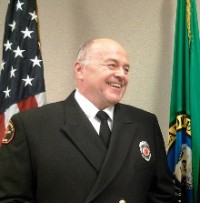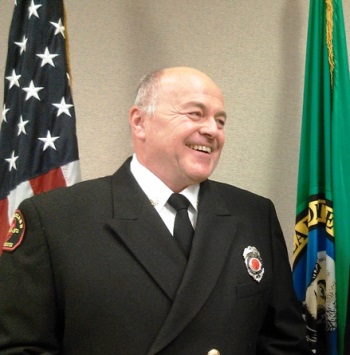— by Margie Doyle —
Orcas’ new Fire and Rescue Chief, Mik Preysz, is a citizen of Hungary, Canada, and the U.S. He drinks tea, not coffee. His story has lots of turns, and “not everything’s logical,” he says. What’s obvious is that he relishes a challenge. He admits to feeling nervous initially at taking on the top job in Orcas’ Fire and Rescue District, even after 38 years as a career police officer/EMT, Deputy Sheriff/paramedic, firefighter and administrator.
His association with Orcas Fire and Rescue started back in 1992 as a paramedic and he’s unabashed in describing his career as a Cinderella story where luck (including, as he tells it, being the victim of an armed robbery) has been with him all along the way.
Born in Hungary, and emigrating first to Canada, then the United States, and married to a British woman for 24 years, has immersed him in “three cultures that builds a tolerance,” he says. He’s also the father of three and grandfather of four, including two-year old twins. His wife is a trauma nurse at Peace Island Medical Center in Friday Harbor.
As a certified paramedic since 1981, he practices under a doctor’s license and re-certifies every three years, with continued education, evaluation, and doctor-approved training. He worked from 1992-94 as a full-time paramedic while residing, during his duty days, at the Rosario Station. Putting in nine shifts a month, he was one of four paramedics, the others were Dave Zoeller, Leora Eastman and Mike Damoth, working 72- to 96-hour shifts. He switched his status from on-call to full time FireMedic in August 2005 and was appointed Assistant Chief in January of 2013. At that time, he and his wife moved from Lynden to the island.
With former Chief Kevin O’Brien’s resignation last month, Preysz was tapped to be the Acting Chief of the $2 million district. He and the commissioners agreed to an initial six-month stint, so that, in October he — and the district — can step back and re-evaluate his leadership in the position.
“I’ve never had to work a day in my life, because it’s just fun, with added challenges and vitality,” Preysz says. Upon further investigation, it is learned that, since he was a teenager in Salt Lake City, Chief Preysz has worked as a dishwasher, bellman, bartender, cook, waiter and hotel reservation clerk — and a banker. A defining moment came when he was held up in an armed robbery while working as the night auditor at the Holiday Inn, just one week after the previous night auditor had been held up. The hotel ended up hiring an off-duty Salt Lake City Police officer and Mik ended up doing a lot of ride-alongs with the officer, which led him to applying at several police departments. Mik went on to work for Key Bank and within four months received an invitation for testing with the Bountiful Police Department. He did not hesitate and jumped at the opportunity, scored second out of 200 applicants, and started work as a police officer in July 1977.
He became an Emergency Medical Technician (EMT) as soon as he could in Bountiful, Utah, the “first step” he says in providing basic life support. “In general we don’t supply drugs or treat the patient’s ailments, just stabilize them for the paramedics or transfer to the hospital.” When the county offered a paramedic program with the Davis County Sheriff’s Office, he signed up for that.
The Paramedic Program required 2,500 hours to complete at Weber State University, including residency in the dorm on weekdays and a full course load. It also required a minimum five-year commitment with the Sheriff’s Office, Preysz says, “I thought it was the cat’s meow — here I was a newly-married 22-year old in a demanding profession.”
Preysz says, “It really challenges you. It really tested what you could accomplish when you put your mind to it.”
After completing the paramedic training with scores of over 90%, he worked full-time as a Deputy Sherriff/Paramedic with an EMT partner and began training and teaching at both Weber State University (EMT and Paramedic students) and the Utah State Police Academy (defensive tactics). In addition, he had the opportunity to travel around the state representing the Police Academy instructing officer and park rangers. He gained practice in budgeting and leadership, “with great mentors.” He also coordinated the ambulance service, worked on and commanded the search and rescue and S.W.A.T teams with the Sheriff’s Department. He performed his police and medic roles with boats, motorcycles snowmobiles and even helicopters with LDS Hospitals Life-Flight Program. “They paid me to be flying at 10,000 feet, taking care of emergency patients while over the Rocky Mountains.”
He remembers most vividly one particular incident where he resuscitated a child trauma victim from a car-bicycle accident. The injured child ended up surviving three additional days. Mik remembers asking himself repeatedly, “What could I have done differently?” Later on, he was thanked by the girl’s parents for giving them three days of life to say goodbye to their daughter.
Also, as an armed police officer with only a few months’ experience, he recalls tracking a murder suspect on foot through the snow. He hadn’t yet developed much “situational awareness” and was focused on the footprints when he suddenly realized the suspect was right above him in a tree. “If he’d still had his gun it could have been a different story,” Preysz says, shaking his head.
In October of 1989 on a trip up and down the Pacific coast looking for jobs, he arrived in Bellingham, and went to St. Luke’s Hospital where he met with Linda Nelson, the Director of the Emergency room. Within one hour, not only did he have a job offer but his wife-to-be, Lesley, was also hired for the emergency department and Med-Flight, sight unseen.
Several years later Mik remembers asking Linda how was she so sure that Lesley and he would work out. Her reply, “I have never made a mistake in hiring a nurse or paramedic that I felt good about.” For the next seven years, Mik worked in the North Region, as a paramedic on Med-flight, became a medic with Orcas Island Fire Department and secured a full time position with Skagit Medic One in 1994, working with Dave and Leora. In the summer of 2005, Mik applied and received the full-time position as one of three FireMedics with the Orcas Fire Department; Patrick Shepler and Valerie Harris, being the other two.
“I understand Orcas; I wanted to take on the challenge of being Chief because I care about the community. The challenge is phenomenal. I want to continue fostering our reputation as an elite department providing better services than any mainland department can offer. And I feel it is very important to keep stability within Orcas Fire and the Community in the services we provide.
“There’s a shift in health care on the island, nationally and internationally for EMS agencies to take a more pro-active role to keep people out of hospitals and nursing homes and help them improve their quality of life while remaining in their community. People want to stay home, and the call volume has increased. The need for intervention before it comes to a 911 call is significant. The paramedics are taking a more active role in home care, which is a concept I’ve been looking at since 2007. We never leave a scene until we know there is follow up. Follow-up care after a call is undertaken by Orcas Cares, a support organization coordinated by Marla Johns, Rita Harvey, Pat Ayers, and Alan Stameisen.
“The goal is to extend and improve the quality of life on Orcas Island for those who want to stay here; to provide the resource to get people to the right place,” says Preysz.
One of his primary concerns is maintaining stability “so that I can mentor others to take my job and do it better than I can, because that’s what it’s all about.” A step in this direction was appointing, through the Bureau of Fire Commissioners, the four-paramedic captains to Battalion Chiefs, meeting a Washington Ratings Bureau requirement of having a chief officer on every fire. “We must prepare Orcas Island for the coming years of changes that are the result of health care and fire service reforms,” Preysz says, “to make sure we maintain qualified, well-trained volunteers and hire responding and administrative support staff.”
His biggest worry now is that with “volunteers so dedicated and willing to help, we must meet the increased demands on training and services without over-taxing the volunteers’ time or their safety.” His challenge is “to make sure the tools, equipment and education are good enough for the workers to go home every night.” Yet he values that everyone has input. “We come up with the best solution by using our collective brain trust.”
He values the eclectic nature of the Fire and Rescue District members: “We have volunteers who have made their fortunes, and volunteers who can’t make minimum wage, and they all come together in such purposeful movement to get things done.”
Apart from the staff and volunteer members, the public can help with administration, vehicle transport and role-playing as “patients.” In addition, the Auxiliary comes to 24-hour incident scenes with food and beverage; and Judy Madan heads the CISM team with social support “for responders who went through a tough scene and want to pour their heart out.
“I understand the community and believe in the people that are serving it. My job is to allow them to build up their weaknesses and nourish their strengths so they can rise to their full potential.”
**If you are reading theOrcasonian for free, thank your fellow islanders. If you would like to support theOrcasonian CLICK HERE to set your modestly-priced, voluntary subscription. Otherwise, no worries; we’re happy to share with you.**










We are so very fortunate to have someone of Mik’s caliber on Orcas.
What a great biography! Being a former member of OIFR, (now in Portland, so volunteering would be quite difficult from this distance) I have had the opportunity to have been an EMT/FF w/ Mik as a Paramedic. I am glad to know OIFR has Mik @ the helm!